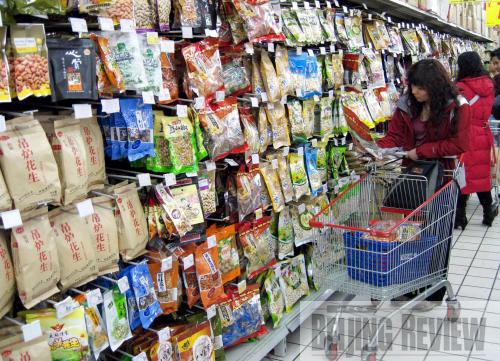|
 |
|
SAFER MARKET: People shop for groceries in a Beijing supermarket. Many of the modern food packages have embraced RFID tags (XINHUA) |
Food safety inspectors will be tuning in to enforce the strict new food safety law that just came into force on June 1. One of the tools they will rely on to get the job done is in the form of radio frequency identification (RFID) tags, chips using radio waves to identify and track products.
RFID tags are used to replace the ubiquitous barcode system that requires contact or close proximity to work. RFID data can be read through the human body, clothing and non-metallic materials. The tags can also be reused many times and can withstand heat and dirt.
The RFID tag's characteristics give it the upper hand over barcoding when tracking food production from raw materials and processing to transportation and storage. The information of production chain associated with a piece of food can be recorded onto RFID tags, which can help to trace problems before consumption. Authorities hope this technology can help to build a better regulated food market.
In 2003, early in China's application of radio frequency technology to food tracking, the country attached RFID tags to fish raised in Qiandao Lake, Zhejiang Province. It was the first time China tagged fish products, which enabled customers and market administrators to track the food from water to table.
 |
|
HI-TECH TICKETS: Tickets for the Shanghai Expo employ similar technology to these used for the Beijing Olympic Games (GAO XIAOTIAN) |
A basic RFID system needs four components to work: a transponder tag, a transceiver reader, an antenna attached to the reader and software that allows the tag to give its information to a computer.
The transponder tag holds unique identifying information. The transceiver reader emits and receives radio wave communication through its antenna and passes tag information to a computer attached to it.
The radio wave sent by the reader has the power to activate any tags nearby, which then emit their unique identifying information. The response is picked up by the antenna, sent to the reader and passed to the software that makes sense of it. The software, called middleware, can sort thousands of tag signals and makes it available on a computer for record keeping, analysis and management.
Besides product tracking, RFID is also used in passports, transportation payments and enterprise supply chain management to improve the efficiency of inventory tracking and management. RFID tags can be engineered as small as grains of powder, which makes them easy to conceal. Some tags can be read from several meters away and beyond the line of sight of the reader.
Revolutionalizing the Expo
The World Expo 2010 Shanghai will last 184 days and attract around 70 million visitors from more than 200 countries and regions. A paper co-authored by Wen Xuesong and Huang Guanwei of the Sino-German College at Shanghai-based Tongji University said food safety would be a major measurement of success for such a gigantic event. According to the authors, Shanghai should establish a food safety system consisting of monitoring, warning and emergency response, which covers the material production bases, processing plants and information management. The paper said RFID technology would play a vital role in this system.
To ensure the Expo's food safety, the paper said, a food production tracking system should be introduced to track food origins in a complicated multi-layer supply network. The system supplied for the Expo should cover every step from production to consumption. "The adoption of RFID tags is an effective tool to track food origins since it can record point of production and every processing step. Thus we could track down the origins of all the foods sold at the Expo," wrote the paper.
| 